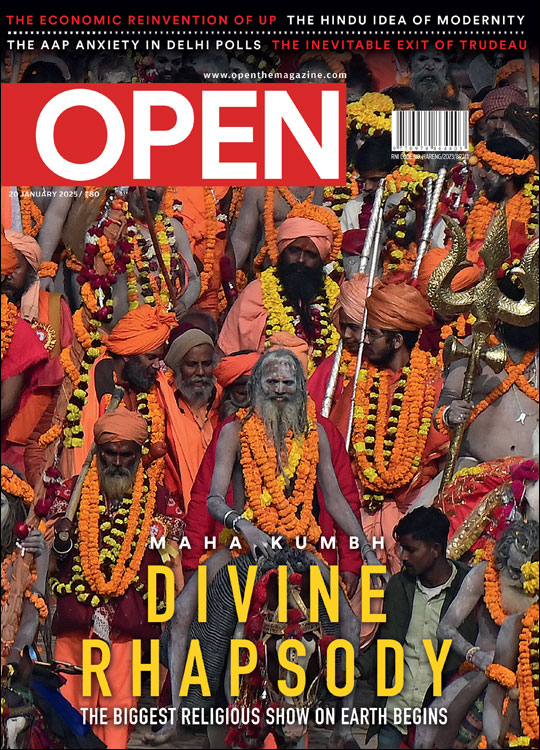Shaky Foundation
India’s evolution is held back by a deep institutional malaise
 Shashi Tharoor
Shashi Tharoor
 Shashi Tharoor
Shashi Tharoor
 |
20 Jul, 2017
|
20 Jul, 2017
/wp-content/uploads/2017/07/Openessay_1.jpg)
SOON AFTER HE was elected Prime Minister in 2014, Narendra Modi made a speech about the need to make it easier to do business in India. He deplored the fact that it took 200 steps to open a store in our country, whereas in the US, he said, it only took six. He delivered the speech with his usual brilliance of articulation and a flair for rhetorical flourish. Then he moved on to the next event. Three years later, it still takes 200 steps to open a store in India.
The episode can be used to point to the present Government’s talent for making promises it does not fulfil, or the Prime Minister’s habit of picking up and highlighting different issues but not ensuring that his diagnosis is followed up with a prescription and the actual delivery of medicines for the disease. It also reveals, however, the state of public institutions tasked with governance in our country, which have been unable to follow up on the Prime Minister’s commitments.
Three years after the Prime Minister with a crushing majority in Parliament pledged to improve India’s ‘ease of doing business’ global rank from 134th to somewhere in the top 50, the results are not encouraging.
According to the 2016 edition of the ‘Doing Business’ indicators, India ranks 130th out of 189 countries in the overall ease of doing business, 155th in the ease of starting a business, 178th in enforcing contracts, and 183rd in getting a construction permit. The speeches will continue to be made, but the good intentions are a long way from being implemented.
As Arun Shourie once memorably put it, “In India, when all is said and done, much more is usually said than done.”
That’s the problem. Public institutions are the strength of any democracy. However, as India has undergone significant transformations—economic, social and political—in the seventy years of our independence, our public institutions have failed to keep pace. India’s continuing evolution, say the editors and authors of Rethinking Public Institutions in India edited by Devesh Kapur, Pratap Bhanu Mehta and Milan Vaishnav (Oxford University Press, 2017; 597 pages; Rs 995), is held back by a deep institutional malaise. India’s response to multiple challenges, including rapid urbanisation, low agricultural production, weak human capital, widespread corruption and environmental degradation, will determine its future—but the institutions required to manage our responses to these challenges need significant enhancement.
The principal goal of the book, which has emerged from a 2013 conference on the same theme, is to examine the institutional foundations of the Indian State and the organisational and institutional context in which it operates. A decade ago, a conference on ‘Public Institutions in India’ organised by two of its editors (Kapur and Mehta) had focused on the key federal institutions of the Indian Republic and led to an earlier volume, Public Institutions in India: Performance and Design. A subsequent conference in July 2013 on ‘Building an Indian State for the 21st Century’ reflected continuing doubts on the ability of our institutions to mediate complex forms of knowledge and elicit widespread social acceptance. Neither the Parliament nor judiciary, nor bureaucracy nor police, nor any of the country’s investigative agencies or numerous regulatory agencies, are, the book avers, on a path to regeneration. The biggest question mark over India is the extent to which improvements in the quality of life are being constrained by the mismatch among institutional design, politics and developmental needs.
So how do we set about improving the capacity of India’s public institutions? The authors feel that that the key to doing this is to successfully rejuvenate our core public sector institutions. This will also go a long way towards realising India’s developmental objectives at home and enabling our ambitions abroad.
India has sometimes managed to do well despite institutional deficiencies. The best example is the economy: although not as dizzying as China’s, India’s economic growth has been remarkable, and in many ways transformative. Yet it has been argued that India’s improved economic performance has largely been in spite—and not because—of the state. As the old saw goes, India grows at night, when the Government is asleep. When it is awake, the Government serves as an impediment, a source of extraction and a fount of corruption and rent-seeking. (Of course this is an exaggeration, but the fact that the perception exists is not a great advertisement for our institutional system.)
In addition to high levels of corruption and venality in public life, the authors find a lack of competence at the policy design and formulation levels and further incompetence at implementing government policies. Regulatory bodies suffer from the same problems: insufficient authority, weak human resources, overlapping mandates, lack of legitimacy and political interference. To make matters worse, the capacity of our states to effectively design and implement public policy varies across India, so that, say, civic institutions that function well in Jaipur may be near non-existent in Jhansi.
So how do we set about improving the capacity of India’s public institutions? The authors feel that that the key to doing this is to successfully rejuvenate our core public sector institutions. This will also go a long way towards realising India’s developmental objectives
The number of people living in India’s urban cities and townships is rising so swiftly that the Government’s own agencies have difficulty adequately measuring the country’s changing demographics. About a million Indians are reaching working- age every month, and we don’t have jobs for them. India’s young people are increasingly informed and interconnected. Providing capable and responsive governance to manage their new and increasingly demanding expectations is not easy.
But are we up to it? The list of ‘capacity gaps’ in the system is dismaying:
· India’s population increased from 846 million to 1.2 billion between 1991 and 2011, while total public sector employment decreased from 19.1 to 17.9 million.
· As of January 2014, according to the Seventh Pay Commission, 56 ministries of the Union Government had 792,000 vacancies, or a shortfall of 19 per cent.
· The size of the IAS dropped by 10 per cent; by 2010, the total strength of IAS and IPS was less than 11,000, but the vacancy rate was 28 per cent.
· The strength of the Indian diplomatic corps is less than Sweden’s or New Zealand’s.
· India’s judicial system has a backlog of more than 31 million cases; 10 per cent have been pending for more than a decade, according to government estimates.
· The Indian Army faces a critical shortage of officers. There were more than 9,000 vacancies in 2015, the Army recruited 1,900 but 1,000 retired.
· As many as 8,000 posts are lying vacant in the Intelligence Bureau.
· Eight out of 10 assistant commissioner posts for the Maharashtra State Anti- Terrorism Squad are vacant, despite the deadly and humiliating attack on Mumbai of 26/11.
· India has one of the lowest per capita police rates among major countries (1.3 constables per 1,000 citizens); official estimates of police vacancies stand around 23 per cent (0.5 million of 2.2 million posts).
IT’S A CLICHÉ that India is a land of paradoxes, but it is truly striking that it can organise elections for 850 million eligible voters, conduct a census for 1.2 billion people and run a successful space programme, but on the other hand it cannot provide basic public services like healthcare, quality education, safe drinking water and adequate sanitation to its people. The expansion of India’s private sector and civil society has to some degree compensated for the deficiencies of the state and substituted for some of the shortcomings of the public sector. But 265 million poor and underprivileged people rely on the state for functions that the private sector cannot help them with. They require public assistance for most of their needs and our public institutions must have the capacity to meet these needs.
Indians have the imagination to take new initiatives, but our institutions, while proving able to adapt to the new objectives, are usually unable to cope with them. The panoply of new rights introduced by the UPA Government—the Right to Information, Right to Education, Right to Food, Right to Landholding—have all imposed new obligations on the state. All legally enforceable rights require resources, and all resources have opportunity costs. But in less than a decade after its establishment, the RTI’s ultimate appellate body, the Central Information Commission (CIC), faces a serious backlog of cases. The authors find that CIC staff haven’t opened their mail in months, with more than 10,000 pending requests gathering dust. The growth of Public Interest Litigation, with a plethora of cases flooding in, ranging from the frivolous to the existential, has had the same effect on the apex court.
The number of people living in India’s urban cities is rising so swiftly that the Government’s own agencies have difficulty adequately measuring the country’s changing demographics. About a million Indians are reaching working-age every month, and we don’t have jobs for them
Specific chapters in this volume delve in some detail into areas such as India’s institutions of public expenditure, the work of the Reserve Bank, and regulatory institutions for infrastructure. There’s material on financial accountability that will reward the expert student of our country’s financial governance. (Navroz Dubash argues persuasively that establishing guidelines to enhance accountability and transparency may be among the most significant contributions of regulatory agencies to the challenges of infrastructure governance.) The lay reader will find James Manor’s readable (and often entertaining) chapter on the Presidency particularly timely, though Manor could not have imagined the extent of today’s prime ministerial power when he wrote his essay. One of the problems with the long gestation time required in academic publishing is the risk that some of the judgements and prognoses of scholars can look out of date. Manor’s suggestion that we are in an era of ‘redistribution of power’ from prime ministers to presidents may have been true of the first twenty years from 1989, but became less true thereafter and is wholly otiose now.
The essays on the Supreme Court, the Election Commission, the civil service, Parliament and local self-government are, however, especially relevant. Madhav Khosla and Ananth Padmanabhan note that the Supreme Court has been criticised for a lack of transparency in judicial appointments, with its ‘collegium system’ under which the five senior-most judges control appointments to the Supreme Court and various high courts. The proposed National Judicial Appointments Commission that would replace the collegium passed both houses of Parliament, but the Supreme Court ruled that it was unconstitutional. The process will continue to remain opaque.
The Election Commission, thanks to its constitutional mandate, has been relatively untouched by overt political interference (though without additional safeguards, a future government could move to ‘pack’ the Commission with officers it favours). TR Raghunandan’s chapter on local self-government makes a powerful case for robust and decentralised institutions of governance at the village level, while confirming that these do not exist in India.
MR Madhavan’s magisterial chapter on the functioning of Parliament is so richly detailed as to defy summarising. There could be no more stark indictment of the failure of Parliament to evolve as a public institution than the progressively downward trend in frequency of sittings, accompanied by more frequent disruptions, both of which have undermined the critical deliberative role of a parliament. Madhavan’s research supplies chapter and verse for this deterioration, and for Parliament’s shortcomings with regard to transparency. He also offers a number of interesting suggestions to improve the functioning of parliament, from instituting a right to call a session on the request of 10 per cent of its members, to improving the resources available to MPs, to reserving ‘opposition days’ when the Opposition, not the Government, would set the agenda. Unlike its British counterpart, there exists no separate question time reserved for the Prime Minister to address broad policy concerns; indeed, Modi is more often absent than present in Parliament, and after his first year in office had made more speeches in parliaments abroad than in his own.
One of the more interesting nuggets from this book is that as our country gets younger, the Lok Sabha is getting older. In the first Lok Sabha, there was only one member over the age of 70 and none over the age of 75. In the 16th Lok Sabha, there are 46 members over 70 and 15 over 75. The percentage of young MPs between the ages of 25 and 50 has decreased from 26 per cent in the first Lok Sabha to 13 per cent today. If this means it is not demographically representative, not particularly productive and not at all transparent, then how much credit can Parliament claim as a major public institution in democratic India?
THE BOOK ALSO points to a number of India-specific problems affecting our public institutions. The issue of politicians interfering with institutions goes further than just transfer of bureaucrats to punish or reward them on criteria other than their performance. Politicians have often resorted to arbitrary demotion or promise of post-retirement employment (typically working with a regulatory agency or appellate government agency as a ‘stick’ and ‘carrot’ with IAS officials). In some cases, inaction on the part of the Government constitutes interference. R Sridharan points to cases of repeated absence of action on the part of the CBI when politically powerful individuals are accused of wrongdoing. Inertia, in our system, is often deliberate: vacant positions are left vacant despite the availability of full information on when individuals are going to retire, weeding out possible contenders who will retire too during the pendency, thus paving the way for a political favourite.
A valuable insight is that India needs better and more creative coordination mechanisms: the Prime Minister’s Office and the Cabinet Secretariat are only as effective as the authority of the Prime Minister and the quality of personnel manning these bodies, and can become over-centralised, as we are witnessing now. Coordination dilemmas can be assessed on two dimensions: horizontal, between government agencies, and vertical, between levels of governance (the central cause of the latter being a misalignment between the expenditure and revenue streams).
The authors mention that India’s public institutions are struggling to manage a series of simultaneous transitions: from the wide discretion they have always enjoyed to public accountability for decisions; from a culture of secrecy to one of transparency (exemplified by the RTI); from upward accountability (to superiors) to downward (to the public); from low capacity (in responding to the needs and demands of the citizenry) to high. In the era of Wikileaks and the Panama Papers, public institutions can no longer govern on the presumption that their decisions will remain secret forever, or that they can control the knowledge agenda.
While institutional change is never easy anywhere, the authors find that India’s core federal institutions are badly in need of an overhaul. The Election Commission and RBI are the two public institutions that come out well from the analysis. The rest are weaker than they should be.
A recent WhatsApp message doing the rounds underscores the problem. The writer says he has had to invest in a generator because the state doesn’t supply reliable electricity, purchase a water filter since the official supply is unsafe, live in a gated community because the police can’t guarantee security outside it, install an air purifier because the ambient air is so polluted, and so on (the list is long). He ends with the question: why should I pay taxes to the state when I am spending out of my pocket for all the things the state should be providing through my taxes?
The answer does not lie, of course, in privatising the commons, but in enhancing state capacity to do what the state is supposed to do. This impressive, dense volume offers an enormous amount of material on where our public institutions stand and how they could do better. It will reward the serious student of public administration as well as the concerned lay reader. One can only hope that it will not be too long before things improve to the point where a new edition is required.

/wp-content/uploads/2025/01/Cover_Kumbh.jpg)













More Columns
The lament of a blue-suited social media platform Chindu Sreedharan
Pixxel launches India’s first private commercial satellite constellation V Shoba
What does the launch of a new political party with radical background mean for Punjab? Rahul Pandita